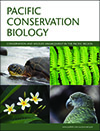
Pacific Conservation Biology
Volume 28 Number 6 2022
Research may be influential without stimulating researchers to cite it in a manuscript.
A literature review and analysis did not support assertions that introduced red foxes (Vulpes vulpes) destroy ∼95% of nests of Australian freshwater turtles, are more efficient nest predators than Australian native species, and are driving Australian turtles to extinction. Targeted measures are suggested to increase recruitment of Australian freshwater turtles where necessary.
PC21058 Abstract | PC21058 Full Text | PC21058PDF (403 KB) Open Access Article
PC21057Bearing all Down Under: the role of Australasian countries in the illegal bear trade
 , Lalita Gomez, Sarah Heinrich, Pablo García-Díaz
, Lalita Gomez, Sarah Heinrich, Pablo García-Díaz  , Sarah Stoner and Chris R. Shepherd
, Sarah Stoner and Chris R. Shepherd
Illegal wildlife trade is a leading cause of biodiversity loss globally. Australia and New Zealand are destination countries for an array of bear parts and derivatives, despite not having any native bear species themselves. In order to combat the illegal trade in bears, non-range countries need to ensure they are participating in global conservation and enforcement activities.
PC21049Indigenous peoples’ attitudes and social acceptability of invasive species control in New Zealand
 , Gary Garner, Melanie Mark-Shadbolt
, Gary Garner, Melanie Mark-Shadbolt  , Jovana Balanovic, Edith MacDonald, Ocean Mercier and Janine Wright
, Jovana Balanovic, Edith MacDonald, Ocean Mercier and Janine Wright
In response to declining support for pest control in New Zealand and growing concerns for proposed technologies, we sought to identify potential drivers of attitudes to pest control. This manuscript reports on 1015 survey respondents who identify as Indigenous Māori. Current attitudes have come about from a lack of engagement and concerns over impacts combined with an increasing distrust of authority.
PC21049 Abstract | PC21049 Full Text | PC21049PDF (1 MB) | PC21049Supplementary Material (325 KB) Open Access Article
In this paper, we explorehow declining rainfall in southwestern Australia is impacting old growtheucalypts and resident avifauna of the Dryandra woodlands. Using long term dataon rainfall and satellite imagery of Eucalyptuswandoo canopy cover, results show a continuing declining trend inaverage rainfall that is accelerating. Also, we found that rainfall is a predictor oftree foliage cover, which is also declining over time. Our analysis of bird mist-net trapping data and tree canopy data indicate that foliagecover is a predictor of the number of yellow-plumed honeyeaters captured, butnot a predictor of rufous treecreepers. The apparent survival rate of the yellow-plumedhoneyeater was half that of the rufous treecreeper.
PC20078 Abstract | PC20078 Full Text | PC20078PDF (2.1 MB) | PC20078Supplementary Material (537 KB) Open Access Article
PC21022The diversity of plant species used in traditional herbal massage oil in Indonesia
This study investigated how three tribal communities in Indonesia utilised plants for massage oils with the aim of preserving their traditional methods. Traditional knowledge could be eroded by globalisation. Therefore, the cultivation and conservation of wild plants is needed. Traditional herbal oils contain various active compounds that possess medicinal values.
PC21022 Abstract | PC21022 Full Text | PC21022PDF (1.4 MB) Open Access Article
Aichi Biodiversity Targets induced positive effects on scientific productivity, quality and international collaboration in the interdisciplinary topic at the national level. Although we found international collaboration to be an effective measure to improve scientific quality and quantity, its effects were constrained by the trilemma between quantity, quality and cost.
PC21017The shortfin devilray (Mobula kuhlii) aggregates at Pulau Si Amil, Sabah, Malaysia
Consistent aggregating behaviour of the shortfin devilray (Mobula kuhlii) is reported from an islet off the east coast of Sabah, Malaysia. Key knowledge gaps remain with this Endangered species, including distribution and habitat use, so this rarely-seen behaviour from a data-poor region highlights potentially important habitat preferences for the species.



